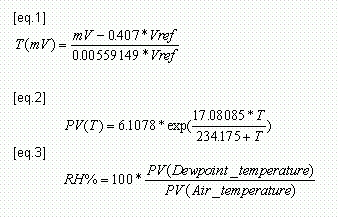Several formulas must be used to get the temperatures, than the relative humidity of the air from these two voltages. The NTC sensors need a reference voltage: this is Vref = 2.513 V in our case.
1. Temperature in degrees Celsius from NTC and Vref voltages: [eq.1]
2. Vapour pressure in [HPa] from temperature in [Celsius]: [eq.2]
3. Relative humidity in percent from the 2 vapour pressures. [eq.3]

An example:
Kai = 1400 mV and Kde = 1300 mV
T_air = 26.8 degrees Celsius, T_dewpoint = 19.7 degrees Celsius, rel. humidity = 65%
Attention:
One should not be surprised if the Kai temperature is higher than the temperature recorded by the normal air temperature sensor (T_air); the Kroneis NTC sensors are well protected from most direct wind gusts, and somewhat exposed to radiation reflected by the roofs silver rain-proof painting; so there certainly will be a noticeable difference between air temperatures measured during sunny hours. As both Kroneis sensors are located at the same position, this should not affect the true relative humidity of ambient air.
Technical details:
The Kroneis dew-point sensors are used by the Austrian TAWES meteorological system (Zentralanstalt für Meteorologie und Geodynamik, Hohe Warte 38, A-1190 WIEN)
Sensor type: dew-point sensor no. 620
Manufacturer: Dipl.Ing. A. und W. KRONEIS, Iglaseegasse 30-32, A-1191 WIEN
francis.massen@ci.educ.lu